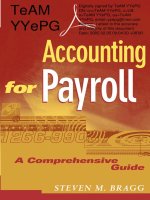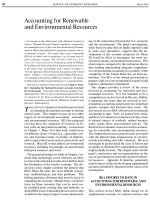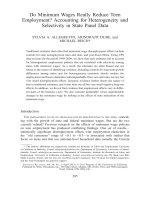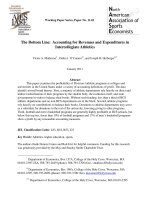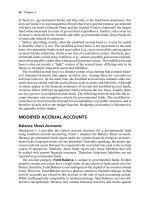235. Topic Accounting for Payroll And
Bạn đang xem bản rút gọn của tài liệu. Xem và tải ngay bản đầy đủ của tài liệu tại đây (709.76 KB, 87 trang )
MINISTRY OF FINANCE
ACADEMY OF FINANCE
----------------------------------
Student: NGUYỄN THỊ HOA
Group: CQ54/51.02
GRADUATION THESIS
Topic: Accounting for Payroll And
Payroll Deductions At
Thien Ung Services Training Company Limited
Major: English for Finance and Accounting
Student code: 165D2202010048
Supervisor: MSC. Cao Phuong Thao
Ha Noi - 2020
Graduation Thesis
RESEARCH PROPOSAL
DETAILED OUTLINE
DECLARATION
ABSTRACT
ACKNOWLEDGMENTS
LIST OF ABBREVIATIONS
LIST OF FIGURES AND TABLES
TABLE OF CONTENTS
INTRODUCTION
1.Rationale of the study
2.Aims of the study
3.Scope of the study
4.Methodology of the study
5.Organization of the study
CHAPTER 1: LITERATURE REVIEW.
1.1. Overview of payroll and the payroll deduction
1.1.1 Definitions
1.1.1.1 Paroll
1.1.1.2 Payroll deduction
1.1.1.3 The roles, tasks and functions of accounting for payroll and payroll deductions
1.1.2 Payment methods
1.1.2.1 Job-based salary
1.1.2.2 Time-based salary
1.1.2.3 Other forms of payment
1.2
Accounting for payroll and payroll deductions
1.2.1 Definition and role of accounting for payroll and payroll deductions
1.2.2 Accounting for payroll
1.2.2.1 Vouchers used
1.2.2.2 Accounts used
1.2.3 Accounting for payroll deductions
1.2.3.1. Social insurance
1
Graduation Thesis
1.2.3.2 Health insurance
1.2.3.3. Unemployment
1.2.3.4. Trade union
1.3
Accounting books used
1.3.1 General Journal
1.3.2. General Ledger
1.3.3. Journal voucher
1.3.4. General journal voucher
1.4 Factor influencing accounting for salary and salary deductions
1.4.1 Internal factors
1.4.2 External factor
CHAPTER 2: THE STUDY
2.1. Overview of Thien Ung Service Traning Company Limited
2.1.1 Establishment and development of Thien Ung training service accounting
company
2.1.2 The main activities and the organization of Thien Ung training service
accounting company
2.1.3. The features of accounting system of Thien Ung training service accounting
company
2.1.3.1. Organization of the accounting system
2.1.3.2 Accounting form, applied accounting policy and reporting system at the
company
2.1.3.3. The feature in condition of using accounting software
2.2 The current situation of accounting for payroll and the payroll deductions at
Thien Ung Service Traning Company Limited
2.2.1 The features of labor, payroll and payroll deductions at Thien Ung training
service accounting company
2.2.2 Payment methods and salary calculating methods
2.2.3 Vouchers and accounts used
2.2.4 Accounting for salaries and bonuses
2.2.5 Accounting for payroll deductions
2.2.5.1 Social insurance
2.2.5.2 Health insurance
2.2.5.3 Unemployment insurance
2.2.5.4 Trade union fees
CHAPTER 3: Recommendations
2
Graduation Thesis
3.1 The evaluation of current situation of accounting for payroll and the payroll
deductions at Thien Ung Service Traning Company Limited
3.1.1 Advantages
3.1.2 Disadvantages
3.1.3 Causes
3.2 Suggestions to improve accounting for salary and salary deductions at Thien
Ung Service Traning Company Limited
3.3.1 Improving payroll management
3.3.2 Adjusting salary calculation form
3.3.3 Improving training of manager and workers
3.3.4 Improving salary policy
3.2.5 Using reasonable bonuses policy
CONCLUSIONS
REFERENCES
APPENDIXES
3
Graduation Thesis
DECLARATION
I guarantee that this thesis is my own work and it is my own experience in the training
time.
The data and results described in the thesis are exact and it originate from the actual
situation of the practice company.
4
Graduation Thesis
ACKNOWLEDGEMENT
Firstly, I would like to express sincere thanks to Academy of Finance (AOF) for giving
me opportunity to study and research my into educational reality
I do not know how to express my appreciation to Ms. Cao Phuong Thao, my
supervisor, who gives valuable advice, perceptive comments as well as her enthusiasm
supports and careful supervision.
I really appreciate all my lecturers at the Academy of Finance for their assistances,
directions and encouragement, it is main factor for me to complete excellently the
study of educational reality.
I have furthermore to thank for the help of THIEN UNG SERVICE TRAINING
COMPANY LIMITED and people in the company who give me opportunity to
practices in the company in the pastime
Especially, my friends from Foreign Languages also supported me in my thesis, I
would like to thank them for all their support and suggestion. I also would like to give
my thanks to my beloved family crating motivation for me to complete my graduation
thesis.
Finally, because of limitation of time and knowledge, my mistakes are unavoidable, so
I wish to have more opportunities. I also wish to receive more contribution and
suggestion to get a better project.
5
Graduation Thesis
ABSTRACT
New In the current period, the trend of integration and globalization of the world
economy takes place, enterprises in general are under pressure of competition by other
country. Therefore, in order to increase the integration process and improve the
efficiency of the production and business activities, businesses need to find effective
working methods. The important goal of a business is to maximize profits. The profit
earned by a business depends on both objective and subjective factors. Payroll regime
is also an importance factors that company should focus on, so this thesis would make
clear this issue.
This study is about the regime of wages and bonuses at THIEN UNG SERVICE
TRAINING COMPANY LIMITED. First, the main purposes are providing deep
understanding about salaries, bonuses, insurances defines their theories and the
important of paying salary for their employee and the necessary of the payroll
accountant. Next, it will consider the applications, the achievements and limitations of
payroll regime at THIEN UNG SERVICE TRAINING COMPANY LIMITED, as an
illustration for the academic background. Finally, there are many proposals and
solution for the company to improve their payroll accounting regime. In conclusion,
this study would have a part in improving the regime of payment of salaries, wage,
bonuses and insurances at the company. Hopefully, the adjustment could help
company get a better payroll regime in the future, and it also would be a great
reference for other company
6
Graduation Thesis
Part I: Introduction
1. Rationale
Labor is the most important input factors of every business. Improving labor
productivity is the basic way to improve business efficiency and create
reputation of businesses in competitive market.
For enterprises, to survive and develop, they must find ways to improve
production and business efficiency. Therefore, the management of wages and
salary deductions must be paid attention. Other activities will not be effective, or
even ineffective if this work will not be paid enough attention.
In today's market economy, labor and salary management organization is an
important content in the business management of enterprises, it is one of the
most important factors that determine quantity and quality of goods and
products.
Payroll and payroll deductions for the employees always receive great concern
because of its social-economic significance. For the employees, these payments
are important because they could be their sole incomes, to support their whole
families’ lives. For every business, it accumulates in the expense account that
takes up a great proportion in total costs. It can be the driving force behind the
increase of labor productivity, if it is paid basing on employee's productivity.
Therefore, how to construct wage regime and how to select an appropriate
payment form are very necessary. Payroll issue is not new, however there are
some deficiencies which are need to adjust to get an effective work of paying
salary, wage, bonus and insurance in enterprises. As the result, Enterprises could
ensure that, their employee can get suitable salary, thus companies can save cost
and increase profits.
7
Graduation Thesis
Understanding the paramount importance of the payroll accounting work in
enterprises so in the process of practice as well as completing the subject of
graduation, with the enthusiastic advices of my teacher - Ms Cao Phuong Thao
and the support of financial accounting department's personnel, I decide to
choose the subject: "Accounting for payroll and payroll deduction at Thien Ung
service training company limited " as graduation thesis topic.
2.3Aims of the study
When studying “Accounting for payroll and payroll deduction”, there are three
main objectives which I want to clarify. First, providing basic information to
understand the concept of salary, payroll deductions, bonus and insurance.
Second, the ways that enterprise use to made payment for their employee, taking
the scenario at Thien Ung Service Training company limited as a case for study,
and reviewing their advantages and disadvantages. Finally, it is to suggest
possible solutions to improve the payroll accounting and the payroll related to
insurance at
3.Subjects and Scope of the study
The study provides analysis and reviews the work of payroll accounting and
payroll deduction at Thien Ung training service company limited. Research
scope: research scope limited in Thien Ung training service company limited
Time study: metrics used mainly are February 2019.
4. Methodology
In order to finish graduation thesis, many methods are applied such as collecting and
synthesizing data, analyzing by tables, diagrams and using mathematical. Firstly,
Methods for collecting and synthesizing data include many ways to
collect information and data supporting graduation thesis. For example, I
work and contact the financial-accounting department of the Company to collect
8
Graduation Thesis
data about payroll accounting and payroll deduction in February 2019 of the
Company. Besides, using many tools to get information about the situation of
payroll accounting and payroll deduction in Vietnam such as: Internet,
newspaper, financial news and many colleagues or studying many graduation
theses and many related topics. Secondly, Comparison is another method. This is
method that used to compare the similarities and differences of an issue. In
reality, applying this method, I compare between theory and practices about
payroll accounting and payroll deductions in the Thien Ung service training
company limited, so finding out the deficiencies of the company. Thirdly, using
analysis by table and diagrams is an efficient method. Finally, I use
Mathematical method which using mathematical formulas to calculate the
payments to the employees.
5.Organization
Chapter 1: Literature review
Chapter 2: The current situation of accounting payroll and the payroll deduction
to at Thien Ung service training company limited
Chapter 3: Recommendations to improve payroll regime and payroll deduction
at Thien Ung service training company limited
9
Graduation Thesis
CHAPTER 1: LITERATURE REVIEW
1.1 Overview of Payroll and Payroll deductions
1.1.1 Definitions
Labor: is the consumption of labor force in reality. Labor is purposeful, conscious
activities of people to create products to serve the needs of society life. Labor is the
most typical and creative activity of man.
The labor costs definition is the total cost of all labor used in a business. It is one of the
most substantial operating costs. These are particularly important in any business
which experience heavy human resource labor costs: construction, manufacturing, and
other industries which have partially or non-automated operations. These costs include
2 main subcategories. The direct labor costs definition is summarized as the cost of
labor which is used directly to make products. Meanwhile, the indirect labor costs
definition is simply explained as the cost of labor which is used to support or make
direct labor more efficient.
Whenever a worker activity takes place, the enterprise must pay for all kinds of
materials, attrition of tools and tools for production process and money paid to
laborers. Labor costs are one of the three cost factors that make up the value of
products made by businesses. High or low labor costs affect product costs. Therefore,
in order to manage production costs well, firstly, it is necessary to strictly control labor
expenses and to manage wages from two basic criteria: quantity and quality of labor.
1.1.1.1 Payroll
Payroll is the total of all compensation a business must pay to its employees for a set
period of time or on a given date. It is usually managed by the accounting or human
resources department of a business; small-business payrolls may be handled directly
by the owner or an associate. Increasingly, payroll is outsourced to specialized firms
that handle paycheck processing, employee benefits and insurance, and accounting
tasks such as tax withholding.
10
Graduation Thesis
Laborers, after using their labor power to create products, shall be paid a certain
amount of wages. On the other hand, we see that labor is exchanged for wages. So
labor can be considered a commodity, a special commodity. And wages are the prices
of those special goods, labor goods. Because goods of labor need to be exchanged on
the labor market on the basis of an agreement between the buyer and the seller,
affected by the law of value, the law of supply and demand. Therefore, labor prices
will vary according to the price of the constituent elements as well as the supplydemand relation of labor. Thus, when considering wages as the value of labor, this
price will form based on an agreement between the employee and the employer.
Payroll may increase or decrease depending on the supply and demand of labor goods.
Thus, the price of wages often fluctuates but it must revolve around the value of labor
power, as other common goods, it requires exactly of its value. On the other hand, the
fluctuations in payroll must ensure the minimum living standards so that workers can
survive and continue working.
1.1.1.2 Payroll deductions
Payroll deductions are amounts withheld from an employee's payroll check, and these
amounts are withheld by their employer. Among these deductions are insurance
pension contributions, wage assignments, child support payments, taxes, and union
and uniform dues. Deductions that are mandated are government taxes; however, all
other deducted amounts are voluntary.
No matter how many hours an employee has worked, payroll deductions must be
withheld from payroll checks. In the event that no deductions are withheld, the
employer becomes liable and responsible for any mandated amounts that were
supposed to be withheld. When an employee's insurance deductions are not withheld,
the employer becomes liable to pay the deductions or to cancel the employee's
insurance policy. It is always an employer's responsibility to make sure any payroll
deduction is withheld in a timely manner.
Payroll deductions include:
-
Social Insurance
11
Graduation Thesis
-
Health Insurance
Trade Union Fee
Unemployment Insurance.
In conclusion, salaries paid to employees, along with deductions for social insurance,
health insurance, unemployment insurance, trade union fee constitute labor costs in the
total cost of production and business.
In addition to the payroll and salary deductions, the company has also built bonus
regime for individuals with achievements in production and business activities.
Bonuses for stimulating employees in production and business activities include:
emulation bonus, reward for improving product quality, saving materials and giving
incentives for technical innovations, …
1.1.1.3 The roles, tasks and functions of accounting for payroll and payroll deductions
The role of accounting for payroll and payroll deductions
Payroll accountancy is one of the most essential accounting functions within an
organization that demands unique set of skills for the management of payrolls of the
company.
Good accounting for payroll and payroll deductions helps the personnel management
in disciplined manner. Also, it creates a basis for enterprises to pay insurance
allowances reasonably.
Well organized accounting for payroll and payroll deductions not only helps manage
salaries strictly, ensuring paying salaries in accordance with policies, but also is a basis
for calculating the allocation of labor costs and business costs properly.
Tasks
The payroll and payroll deductions tasks include the following basic tasks:
-Organizing to record; reflecting and synthesizing data on the number of employees,
time of labor results; calculating wages and deduction of salary amounts, allocating
labor costs according to the subjects of labor use.
12
Graduation Thesis
-Instructing and checking accounting staff in production and business departments and
departments to implement the initial records of labor and wages according to the
proper regime and methods.
-Monitoring the situation of payment of salaries, bonuses and allowances for
employees.
- Making reports on labor, wages, salary deductions, periodically labor situation
analysis, situation of management and spending of salary fund, providing information
on wage labor for the department management in time
Payroll and payroll deductions is not only a noticable topic because it is an importance
expenditure of the business but also a special concern for employees because this is
their right. Moreover, workers use wages to stabilize their daily lives, serving their
daily necessities.
Functions
-Function of measure of value, which is the basis for managing prices properly when
prices fluctuate (including labor).
- Function of encouraging employees: To ensure that workers work effectively and
with high productivity, the principle of wage must be raised to increase economic
benefits for employees, creating passion for the profession, promoting the spirit of
creative work. Employees are willing to self-study to improve professional
qualifications, science and technology, from which work effectively with the adequate
salary.
- Function of supervising employees: Helping the employer through paying wages,
inspecting and monitoring workers who work according to their topics, ensuring the
wages paid as effective as possible.
- Labor administration function: The function of ensuring the role of the labor
coordinator in a reasonable manner with the fair and satisfactory wage, the employee
will voluntarily carry out the work assigned anywhere or anytime.
13
Graduation Thesis
1.1.2 Payroll methods
1.1.2.1 Job-base salary
Payroll by products based on products implies the payment of wages to employees
based on the quantity and quality of completed work products.
Formula
Job
-
based =
Unit of products
x
salary
Job – based salary form including:
Rate per
unit
+ Salary form based on products directly produced by direct labor
Salary paid to employees is calculated directly according to the number of finished
products which reach quality standards.
+ Salary paid for indirect labor
The salary is paid for indirect labors who have no physical association with the
finished product or it’s impractical to trace the costs. So, this form still has several
limitations.
However, there is a clear link between the value of the job performed to the company
and the level of pay when applying this form. So, it helps encourage employees to
work harder and better to improve labor productivity as well as increase their salaries.
However, It is complicated to administer and expensive to operate. This system is
suitable to direct labors. And such a system is most effective in the circumstance
where jobs are clearly defined.
1.1.1.2 Time-base salary
This is a form of payment for employees based on working time, wage level and wage
scale. This method is mainly applied to indirect workers, stable jobs or maybe even
direct workers without product norms.
In the enterprise, the payroll by time is applied to office staff such as administrative
administration, labor organization, statistics, finance and accounting. Time-based
payment is a form of compensation for employees based on their actual working time,
14
Graduation Thesis
occupations and professional and technical proficiency levels of employees. Each
occupation specific job characteristics that apply different wage levels. Professional
and technical proficiency divided into several wage scales, each salary level has a
certain salary, which is the basis for payment of wages, wages over time can be
divided.
Time-based salary per month
As salary paid to employees by month, the wage level is calculated
over time is 1 month.
The actual number
Minium wage
Wage paid in months
=
The number of
x
of working days of
employees in month
working days in
Time-based salary per week
Wages are wages for employees based on weekly wage and number of working days in
a month.
Monthly salary
Wage paid in weeks
=
x
52 weeks
15
12
Graduation Thesis
Time-based salary per day
Hourly rates can be calculated directly to pay hourly rates or based on daily wage for
overtime allowances for employees.
Daily wage
Wage paid by hour
=
The number of working hours in
month as prescribed
The disadvantage of payroll by time is too general, the military sometimes does not
match the actual labor results of the employees.
1.1.2.3 Other form of payroll
Payroll base on turnover is a form of payment / bonus whose income depends on the
turnover achieved according to the sales target and the company's salary / bonus
policy. Usually applied to sales staff ...
There are many types of salary base on turnover
+ Personal salary and bonus
+ Group salary and bonus
1.2 Accounting for payroll and payroll deductions
1.2.1 Definition and role of accounting for payroll, payroll deductions
Definition of accounting for payroll, payroll deductions
Accounting for payroll play a vital role in all companies with a staff of employees.
Both small and large businesses alike must comply with local, state and federal laws
specific to payroll reporting and compliance regulations. In essence, payroll
accountants act as liaisons that perform financial and reporting activities between a
business organization, their employees and the government.
16
Graduation Thesis
Payroll and payroll deductions is not only a notice topic because it is an importance
expenditure of the business but also a special concern for employees because this is
their right. Workers use wages to stabilize their daily lives, serving their daily
necessities.
The roles of accounting for payroll, payroll deductions
Payroll Accountanting and Payroll deductions cover a wide range of tasks that are
essential for timely, accurate and efficient payroll operations abiding by federal, state
and local laws. Payroll Accountants and payroll deducitons need to have a
comprehensive understanding of fundamental tasks, such as paycheck calculations,
taxation principles, preparing ledgers and journals, transfers and journal entries and
deposits. Their main role is responsible for appropriate disbursement of funds,
maintaining and updating employee leave balance information.
1.2.2 Accounting for payroll
1.2.2.1 Vouchers used
Vouchers used in accounting for payroll and payroll deductions are made for the
purpose of monitoring the use of working time, payables for employees in enterprises
such as salaries, wages, allowances, bonuses, working-trip allowances, overtime pay,
payables for other organizations and some other content related to wages or labor.
The accounting vouchers consist of:
- Form 01a – LDTL – Timesheet: is a method for recording the amount of a worker's
time spent on each job by month or by week.
- Form 02 – LDTL – Timesheet for overtime
- Form 03 – LDTL – Wage payment table: Each production group, each management
department creates a wage payment table, which lists the names and the paid wage
amounts of each person in the group.
- Form 04 – LDTL – Bonus payment table: This table is made for each production
group, each department, business division ... these payment tables are the basis for
17
Graduation Thesis
payment and deduction of other amounts such as social insurance, health insurance...
for workers
- Form 06 – LDTL – Overtime pay table
- Form 08 – LDTL – Exchange contract: This form is a contract signed between the
employer and a person about the workload, working time, responsibilities and interests
of each party when performing that job. When the job is done, then the end of contract.
It is also a basis for paying wages to the contractor.
1.2.1.2 Accounts used
Account 334: payable to employees
334: Account 334: payable to employees
This account is used to reflect the amount of money and the situation of the amount of
payments payable to the personnel of enterprises about salaries, wages, bonuses, and
other amounts which belongs to the personnel's income. In enterprises this account is
also used to reflect the wages to pay for outsourced employees.
The structure and the content of reflection of the account 334
Debit
Account 334
Credit
- Deductions of salaries and wages from the
- Amounts payable to employees
employees’ salaries
such as salaries, wages, bonuses
- Salaries, wages, bonuses, social insurance
and social insurance
and other amounts which have been paid or
advanced to employees
Debit balance (if any) shows overpay for
Credit balance shows salaries,
employees.
wages and other amounts payable
to employees.
1.2.3 Accounting for Payroll deductions
Vouchers used
18
Graduation Thesis
Form no 10-LDTL: The list remitted wages
Form no 11-LDTL: Allocation table wages and social insurance
Accounts used
Account 338: "payable and submitted": used to reflect the amounts payable and
submitted to legal authorities, organizations, social associations, for superior about
the expenses of union, social insurance, health insurance, payroll deductions
according to the decision of court (the money raising child upon divorce, legal
costs, etc.) the value of excess asset waiting to process, short-term bet, encash for
someone, keeping money for someone...
1.2.3.1Social Insurance
Social Insurance expense means that expense employers and employees pay to the
government so that people receive money when they are not able to work because of
age, illness, etc.:
Under the current regime, social insurance is calculated that the rate of 25.5% of the
total wage must be paid to employees in each period
In which:
- Employers must bear 17.5% of the total wage or salary included in production
expenses.
- Employees must bear 8% of the total salary by deduction into their salaries.
Account 3383 – Social insurance: reflecting accruement and payment of social
insurance at units.
19
Graduation Thesis
Debit
Account 3383
Credit
- Amounts of Social Insurance fees paid - Appropriating Social Insurance fees
to manage fund agencies of social into operating expenses or salaries of
insurance
employees;
Debit balance (if any) shows overpay Credit balance shows salaries, wages
for employees.
and
other
amounts
payable
to
employees.
1.2.3.2 Health Insurance
Health insurance expense is the expense incurred by a business to pay for its portion
of the medical insurance of its employees. If the expense relates to employees in the
selling and administrative area, the expense is charged in that portion of the income
statement. If the expense is instead related to employees in the production area, the
expense is charged to the cost of goods sold.
Health insurance expense is 4.5% of the total wage payable to employees, in which:
-
Employers must bear 3% and be included in production and business costs.
-
Employees must pay 1.5% by deducting from their salaries.
Account 3384 – Health insurance: reflecting accruement and payment of health
insurance by units.
20
Graduation Thesis
Debit
Account 3384
Credit
- Amounts of Health Insurance fees - Appropriating Health Insurance fees
paid to manage fund agencies of social into operating expenses or salaries of
insurance
employees;
Debit balance (if any) shows overpay Credit balance shows salaries, wages
for employees.
and
other
amounts
payable
to
employees.
1.2.3.3 Unemployment Insurance
Unemployment insurance expenses is the amount of money businesses must pay
employees when they suffer lost a job. Under the current regulations, unemployment
insurance is 2% of the total salary payable for each accounting period, in which the
employer pays 1%, which is included in the production and business costs, the
employees bear 1% by deducting their salaries.
Account 3386 – Unemployment insurance: reflecting accruement and payment of
unemployment insurance by units.
Debit
Account 3384
Credit
- Amounts of unemployment Insurance -Appropriating
Unemployment
fees paid to manage fund agencies of Insurance fees into operating expenses
social insurance
or salaries of employees;
Debit balance (if any) shows overpay Credit balance shows salaries, wages
for employees.
and
other
employees.
21
amounts
payable
to
Graduation Thesis
1.2.3.4 Trade union
Trade union fees
A trade union is an organization that has been formed by workers in order to represent
their rights and interests to their employers, for example in order to improve working
conditions or wages. Therefore, Trade union fees is a grant fund for union activities at
all levels.
-
According to the current regulations, that fees is deducted at the rate of 2% of
the total amount.
-
Salary must be paid for each accounting period and included in the business and
production expenses, including 1% for the grassroots trade union and 1% for
the upper union.
Account 3382 – Trade union fees: reflecting accruement and payment of trade union
fees by units.
Debit
Account 3382
- Trade union fees disbursed at units;
Credit
- Appropriating trade union fees into
- Amounts of trade union fees paid to
manage fund agencies of trade union
fees.
operating expenses or salaries of
employees;
- Overspending trade union fees which
are granted additionally;
Debit balance (if any) shows overpay
for employees.
Credit balance shows salaries, wages
and
other
employees.
22
amounts
payable
to
Graduation Thesis
1.3 Accounting books used
1.3.1 General journal
A Journal entry is the first step of the accounting or book-keeping process. In this step,
all the accounting transactions are recorded in general journal in a chronological order.
The general journal is maintained essentially on the concept of double entry system of
accounting, where each transaction affects at least two accounts.
Other names used for general journal are “journal book” and “book of original entry”.
The process of making a journal entry
The first step in the process of preparing a journal entry is to analyze the accounts
involved in a business transaction and then apply the rules of debit and credit 1based
on the type of each account. After identifying the accounts involved in the transaction
and deciding upon the applicable rules, the journal entry is recorded in the general
journal in a specified format which includes the following details:
1. Date of transaction
2. Ledger accounts involved
3. Amount of transaction
4. A brief narration to describe the transaction
23
Graduation Thesis
Wage payment
table
Special
journal
GENERAL
JOURNAL
Detailed
books
General ledger 334,
338..
General
detailed
reports
Trial Balance
Financial statements
Diagram 1: Diagram of accounting payroll and payroll deductions recorded in the
general journal form
Record daily
Record at the end of the month or periodically
Reconciliation and Examination
1.3.2 Journal Ledger
Journal – Ledger is a bookkeeping form in which arising economic transactions are
combined and recorded in chronologic order and according to economic contents
(according to accounts) into a single general accounting book which is journal ledger.
Accountants or bookkeepers use accounting books such as journal ledger, subsidiary
ledgers and base on accounting vouchers or a summary of vouchers in the same type to
24

